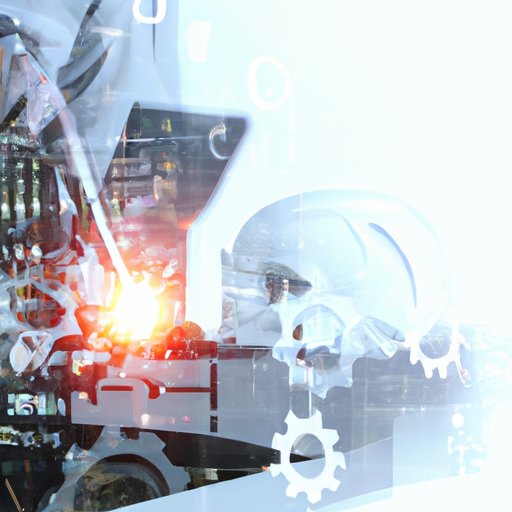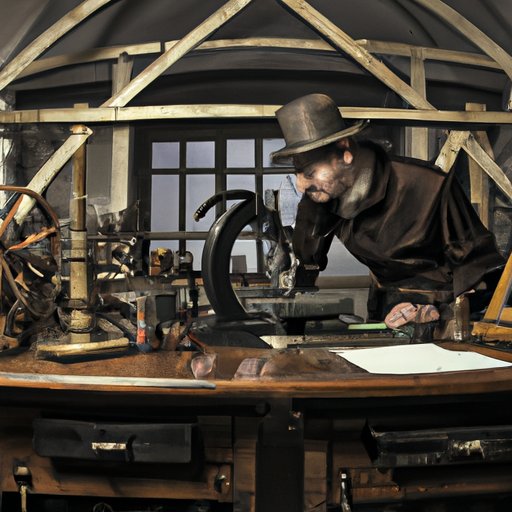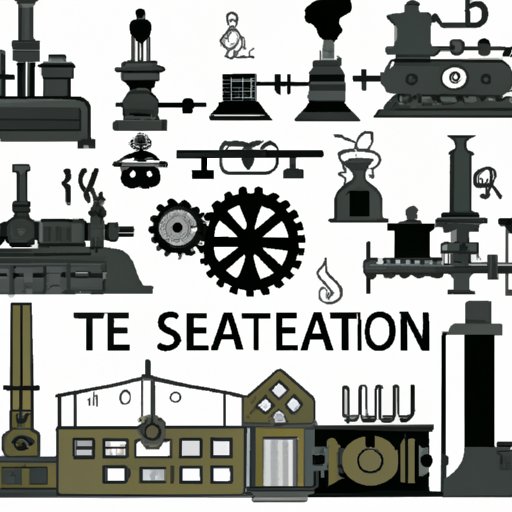Introduction
The Industrial Revolution was a period of rapid industrialization that began in Britain in the late 1700s and spread throughout Europe and North America in the following decades. This period saw a dramatic transformation in the way goods were produced, with the introduction of new technologies and processes that enabled unprecedented levels of efficiency and productivity. In this article, we will explore the various new technologies that helped trigger the Industrial Revolution.
Examining the Impact of New Technologies on the Industrial Revolution
One of the key developments that enabled the Industrial Revolution was the invention of steam-powered machines. The first successful steam engine was developed by James Watt in 1765, and it soon became widely adopted in industries such as mining and textiles. These steam engines allowed for a much higher level of production, as they could be used to power multiple machines at once. This increased efficiency led to a significant reduction in production costs, which made industrial production more profitable.
Textile manufacturing was another area that benefited from the development of new technologies. The invention of the spinning jenny and power loom in the late 1700s enabled cloth to be produced much faster than before. This increased production speed allowed for a greater variety of fabrics to be available at lower prices, which further spurred the growth of the industrial revolution.
Iron and steel production also underwent a major transformation during the industrial revolution, thanks to the introduction of new technologies. The Bessemer process, developed in 1856, allowed for the mass production of steel at a much lower cost. This process involved blowing air through molten iron to remove impurities, and it allowed for the creation of stronger and lighter steel products. This enabled the widespread use of steel in industrial applications, which further accelerated the industrial revolution.

The Role of Innovative Technologies in Sparking the Industrial Revolution
In addition to the development of new machines and processes, the industrial revolution was also spurred by the emergence of innovative technologies. Railroads were an important factor in this regard, as they allowed for the efficient transport of goods across large distances. This enabled factories to access raw materials and markets more easily, which further increased their profitability. The development of the telegraph in the mid-1800s also played a role, as it allowed for instant communication over long distances. This enabled businesses to coordinate their operations more effectively, which further increased their efficiency.
Chemical fertilizers were another important innovation that helped spark the industrial revolution. These fertilizers enabled farmers to increase crop yields without having to use costly labor or animal power. This made agriculture more profitable, which in turn boosted economic growth and provided additional resources for industry. This, combined with the introduction of other technologies, allowed for a higher level of industrial production.
Exploring How New Technologies Enabled the Industrial Revolution
The introduction of new technologies enabled the development of factory systems, which allowed for the mass production of goods. Factories were able to produce goods at a much faster rate than traditional methods, due to the use of specialized machines and division of labor. This greatly reduced production costs, allowing for the production of cheaper goods that could be sold to a wider market. The development of factories also enabled the rise of urban centers, as people moved from rural areas in search of employment.
Improved transportation was another factor that enabled the industrial revolution. The construction of canals and roads allowed for easier transportation of goods between different locations. This made it easier for factories to access the resources they needed, and for the distribution of manufactured goods to larger markets. Improved transportation also enabled the creation of global trade networks, which further increased the efficiency of industrial production.

Analyzing the Technological Advances that Led to the Industrial Revolution
Mass production techniques were developed during the industrial revolution, which allowed for the standardized production of goods on a large scale. This enabled factories to produce large quantities of goods quickly and cheaply, which further increased their profitability. Automation in manufacturing was another important advance, as it allowed machines to operate without the need for human labor. This allowed for the production of goods at a much faster rate, which further increased efficiency.
The use of electricity was another technological advancement that contributed to the industrial revolution. Electrical motors replaced steam engines in many industries, as they were more powerful and reliable. This enabled factories to produce goods at a much faster rate, and it allowed for the development of complex machinery. This, combined with the other advances discussed above, enabled the industrial revolution to take place.

Investigating the Technologies that Paved the Way for the Industrial Revolution
Interchangeable parts were an important innovation that paved the way for the industrial revolution. These parts allowed for the mass production of identical components, which could then be used to assemble various machines. This greatly simplified the process of producing goods, as fewer skilled workers were required. Machine tools were another important development, as they allowed for the precise machining of metals and other materials. This enabled the production of complex parts for use in industrial applications, which further increased efficiency.
Refrigeration was another technology that had a major impact on the industrial revolution. Refrigerators allowed for the preservation of food for longer periods of time, which enabled the mass production of food products. This enabled companies to store and distribute food over larger distances, which further increased the efficiency of the food industry.
Conclusion
In conclusion, the industrial revolution was enabled by the introduction of new technologies. Steam-powered machines, textile manufacturing, iron and steel production, railroads, telegraphs, chemical fertilizers, factory systems, improved transportation, mass production techniques, automation in manufacturing, electricity, interchangeable parts, machine tools, and refrigeration all played an important role in enabling the industrial revolution. These technologies allowed for unprecedented levels of efficiency and productivity, which ultimately led to the industrial revolution.
(Note: Is this article not meeting your expectations? Do you have knowledge or insights to share? Unlock new opportunities and expand your reach by joining our authors team. Click Registration to join us and share your expertise with our readers.)
